Riveting analysis and perspective on idlewords.com (aka the Pinboard guy) as to why we shouldn’t send humans to Mars, but rather save money, turmoil, and blood, and send robots instead.
Quite satisfied with this post-dinner haul from Trader Joe’s for the hotel tonight. Twist-top bottle for wine is the trick.

Zipper Pulls & Usability Experience
Here I go again with another post on zipper pulls.
Why is it I find these things fascinating? First, it helps that I love bags, their design, and the joy they bring in usage (traveling in any form). While some folks derive additional joy out of tweaking, optimizing, and maintaining their hardware (computers, automobiles, homes, et al), bags don't inherently have a lot of maintenance or tinkering, at least not intrinsically.
So naturally, one of the easiest ways to customize and add incremental user interfaces to a bag is through its zipper pulls. I first got into the habit (itch?) for this back when I had my first truly quality bag (Goruck's GR1). Since then, I've bought several other bags/accessories from great manufacturers like Tom Bihn, Aer, Peak Design, and Evergoods, and tinkered with zipper pulls on every one of them. It's fun, it's a way to putz around, and find some enjoyment out of configuring.
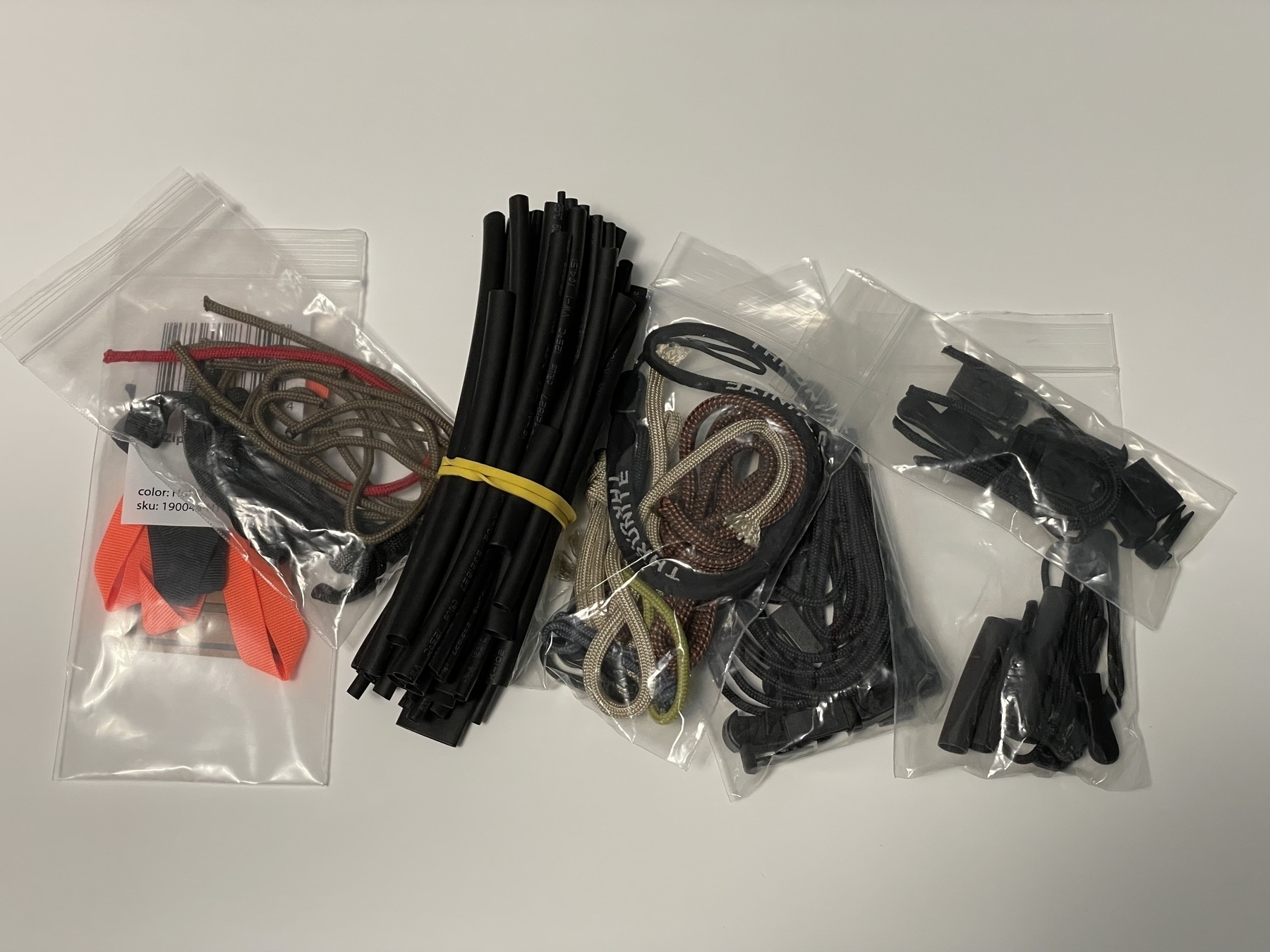
Modifying zipper pulls isn't difficult, either, and the zipper doesn't even need to have a proper slider tab to do it (the typical "pull" for the zipper). Goruck famously removes the tabs and uses heat wax over paracord for a silent zipper pull mechanism that is still one of the best implementations in the industry. If you think about metal zipper pulls on some bags/suitcases, they can be loud and annoyingly jingle every time you move the bag -- Goruck's method, or having a non-metal zipper pull threaded through a zipper tab, can help mitigate the noise or entirely dampen the noise.
Anyway, if you're looking for something incredibly mundane but somehow gratifying to freshen up your bags, this is a good way to go about it!
A little bit of serenity taking a break from the throes of winter back in MN.

As a hot sauce madman, this incredible report of a stranded sea survivor has me brimming with new found respect for the household ketchup.
You love to see the ambition here… surfing in the dead cold of winter on Duluth’s Lake Superior shore.
Stepping through mirrors for short-distance transportation? Count me in.
After just forty pages, I’m tremendously enjoying this first entry in the Mirror Visitor series 📚 by Christelle Dabos.
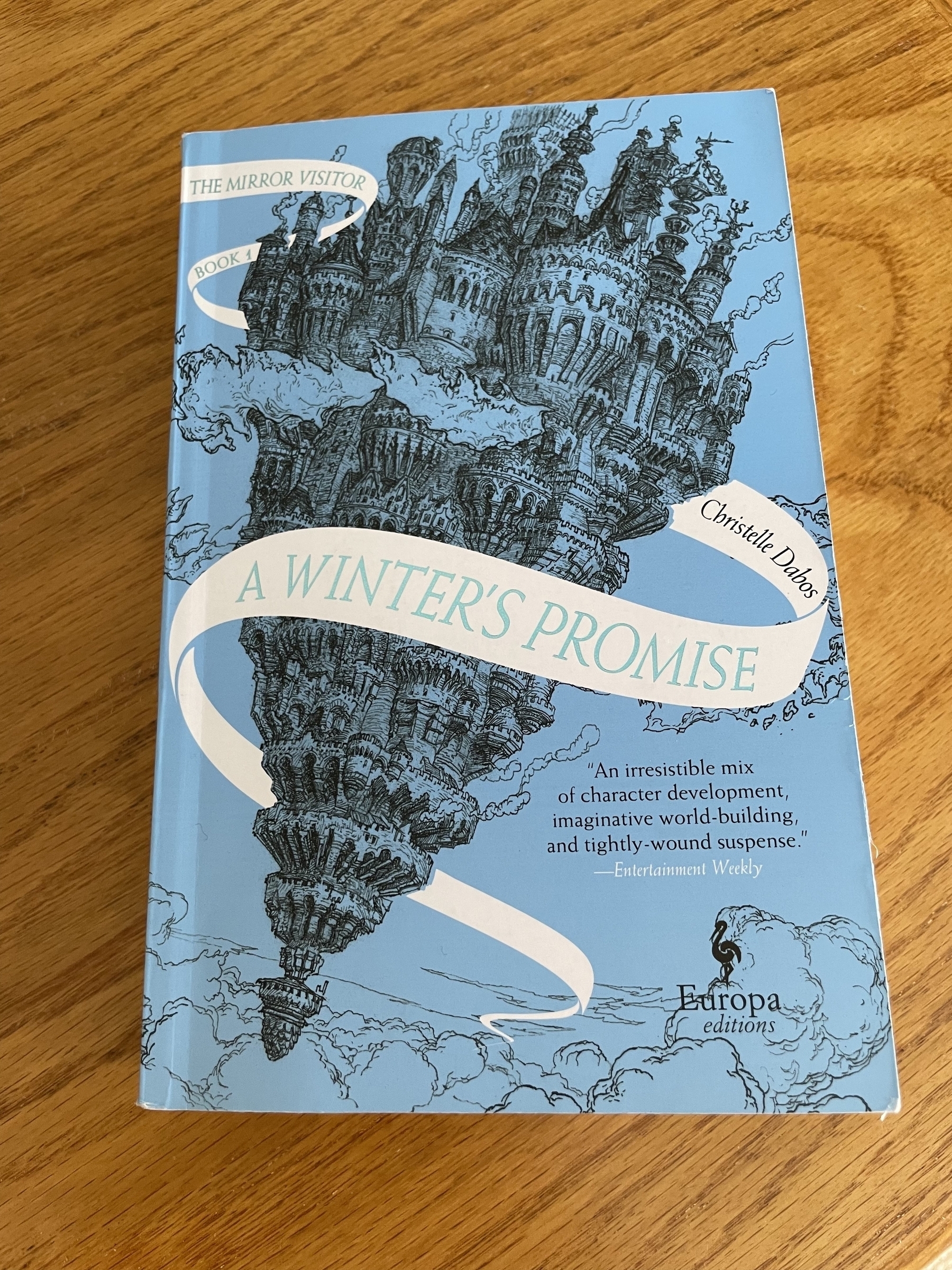
Haven’t watched the show yet, but I wish there was more coverage on the production of these television series – here’s The Verge’s quick bit on Production Designer Mava Sigel’s involvement with Apple TV Plus' Hello Tomorrow.
Really love this piece from the lead developer of NetNewsWire:
If we took money, even a little bit, I’d want to change all that. I’d file with the state of Washington, set up a bank account, start keeping track of income and expenses, separate NetNewsWire stuff from my stuff, start paying taxes. This would take up time I could have spent working on NetNewsWire itself. And I’d hate it.
So that’s problem one. Problem two would be — who gets the money? After we take out $10 a month for expenses, where does the excess go? There are a bunch of people who spend lots of hours every month working on the app — how would we divvy up the money we get? I can’t think of a fair way.
One More Time
Is the third time the charm?
Resuscitating this microblog one more time to meet my sincere ambition to write more frequently. I’ve also decided to pause any further writing on my Squarespace-powered primary site, and use Micro.blog as the vessel. It’s much leaner, works with iA Writer (which is still my go-to writing platform on the Mac for more than a decade), and has integration with Mastadon (the replacement to Twitter, as all signs seem to point to).
And while I’ll keep my Squarespace account, as it’s a pain to migrate off it without serious work to redirect to new URL locations for historic content, I really don’t advocate for anyone to us it for publishing written work – it’s a great platform for businesses, photographers, and creatives, but is a poor substitute for anything else.
An Attempt at Making Kimchi
This is my first go at making kimchi, the beloved Korean use-everywhere fermented cabbage dish. I like it spicy. Very spicy. And that's what I attempted here without much knowledge or craft experience in the space of fermenting.
Actually, I have zero experience.
So pulling off a great batch of kimchi sounded appealing and challenging -- the selective choices in ingredients, the ability to tweak the recipe to the right spice levels, and of course, the sense of accomplishment. These are all great reasons to try it, or so I told myself six days ago.
Astonishingly, I was able to pull this off.

Getting the Ingredients
This was a fairly straightforward operation, but I was lazy on a number of things.
First things first, I needed to build the "kimchi paste", the base layer. I could have been really disingenuous and bought a bottle of kimchi paste online somewhere, but I wanted to "customize" my own, so I went to the nearby Dragon Star Oriental Foods grocery store to find some powdered chili peppers. Since I am so accustomed to finding things myself online, and because I couldn't actually find anyone who worked at the store, I marauded around the chili and condiments aisles hunting for Korean Gochugaru. I couldn't find it, so I found a few chili packets that looked spicy and I had used in a Bloody Mary mix a few years ago. That's probably fine, I told myself. This is an experiment.

For non-kimchi activities, I also picked up some frozen wontons and reloaded on chili sauce. And a few hot sauces. And also some Japanese spicy salt. Something is wrong with me.
I then picked up plain old cabbage (couldn't find Napa cabbage at this or the other grocery store), amd also green onion, ginger, garlic, and daikon radish.
Yes, I was following a recipe from a Fermenting book.
No, I wasn't weighing anything I was buying.
Yes, I misfired on the amount of ingredients. Yes, you guessed right: I didn't get enough cabbage.
Building the Kimchi
I was excited to use the food blender to make the paste. It a was a nice looking attachment to a blender system we got a while back, but never got around to using. After throwing all the kimchi paste ingredients into the blender, it took all of three seconds to whip it into perfect harmony. So that was short-lived.
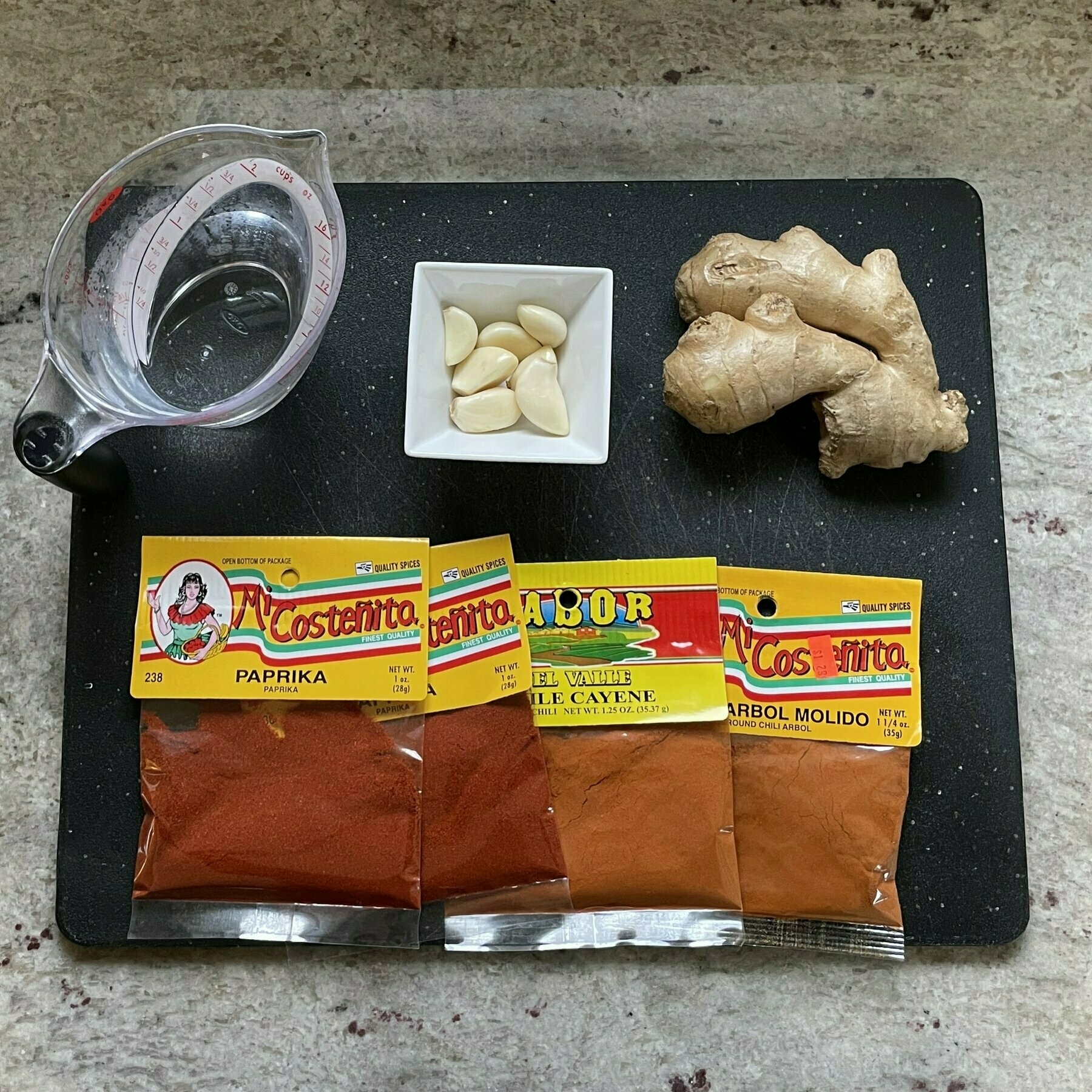
I then carefully cut and threw into a large bowl all the other kimchi primary materials, including the ratio-adjusted paste (after realizing my cabbage was about a third of what I needed), and used some gloves to mix and squeeze and mash everything together. This was fun.
And that was basically it.
I put the amalgamation into a half-gallon Balls jar and screwed a fermenting lid on, then put it downstairs next to all the booze, and waited.
Waiting to Taste the Kimchi
Specifically, I waited six days. I didn't touch the jar, but I did pass by it a few times when going downstairs, and it had a light, funky emanating smell.
I checked it a few times for bubbling (which was happening), and for mold (which was not happening).
I was pleased with how it had been progressing.
How the Kimchi Turned Out
On the sixth day, I opened the container, sniffed the rich, soggy, spicy cabbage odor, and snagged a spoon out of the drawer to taste my creation.
It was potent. It was spicy. It was tangy. It was, through and through, a fairly good tasting kimchi. Not correctly made by any means, as I took shortcuts, but I'm quite pleased with a first trial run of making it at home. Would I gather the right amount of ingredients, including the correct Korean chilis next time? Yes. Would I do anything else differently? No.
Would I recommend making at home? Yes. This is far less expensive than buying the stuff I usually do, even though I need to try and dial in the flavor profile. But the canvas for modifying and adjusting ingredients is wide, and I'm already plotting my next version.
The Joy of Using the Tom Bihn Zip-Top Shop Bag
You have to love the Tom Bihn brand of bags and accessories. They make a great portfolio of products here in the USA (Seattle), all produced with a high level of quality, thoughtful design, material options, many many colors, and, of course, have the brilliant O-ring connected ecosystem.
One of their products shines in its utilitarian genius: the Zip-Top Shop Bag. Like you, I've tried a dozen shop totes that either cost me a couple bucks or were handed out free at some event/magazine subscription. I absolutely advocate for deploying re-usable bags for shopping of any kind. But the bag has to be good to be usable. And most tote bags are complete shit. The Zip-Top Shop Bag is not shit. In fact, it is the best tote bag ever made.
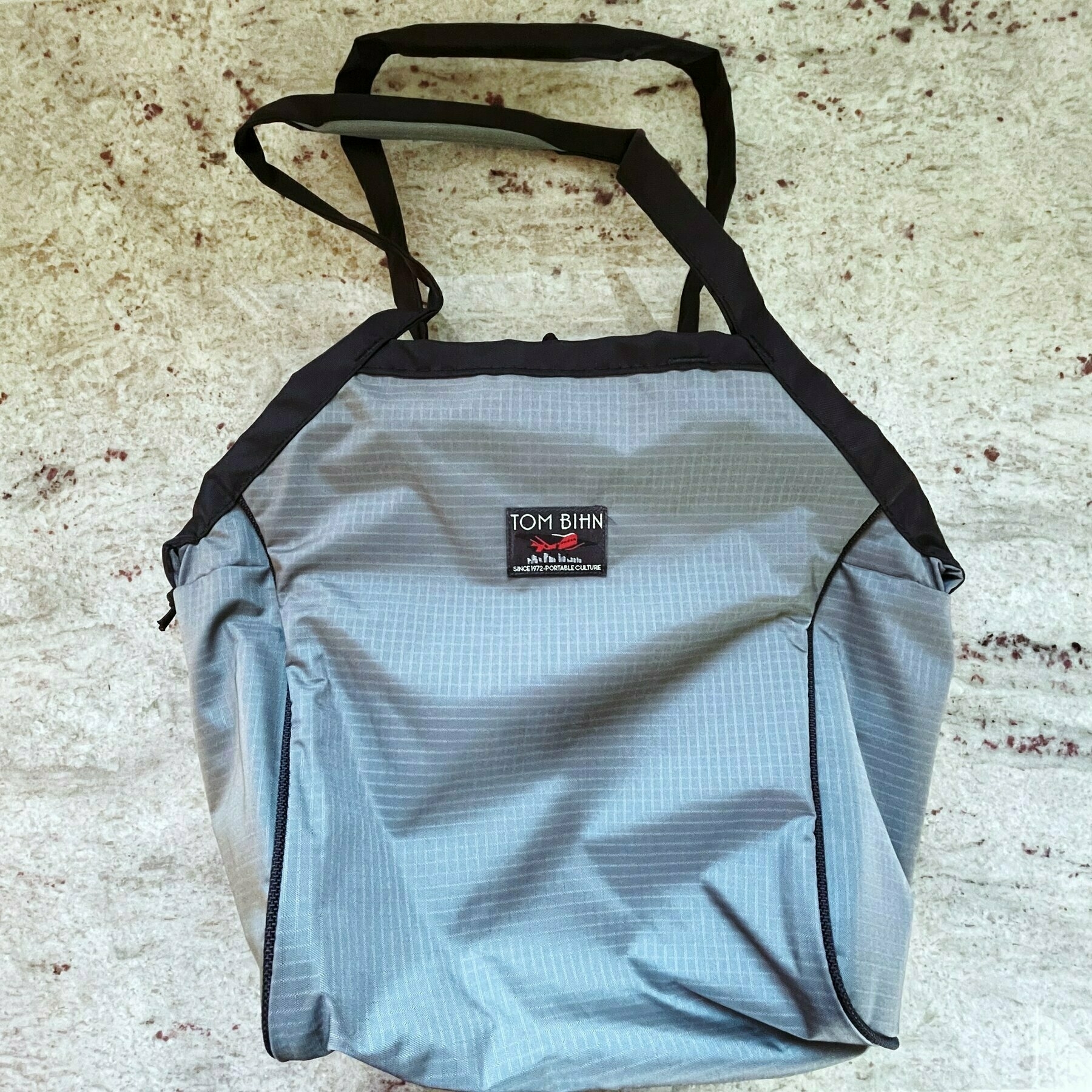
The biggest issue most generic tote bags have is the handle. This critical feature of the bag is often the most poorly designed part of the bag. So often are companies fixated on having their logo or some kind of visual slapped on the side of the bag that they forget you're actually going to be using the bag to tote items around from their store (or other stores). Oftentimes you're loading things into this bag, and then commuting with it a short distance back to your car, or a longer distance on a bus or bike. Thus, the handle needs to be comfortable at all times. It shouldn't dig into your palms like it wants to cut them off when you've aptly used the bag and stuffed it full of groceries. It shouldn't feel flimsy, like it's going to shred off its stitches if the load is too much for its inadequately-constructed purpose. It should work like a dream.

You know what works like a dream? The Tom Bihn Zip-Top Shop Bag. Just look at those handles. They are C-U-S-H-I-O-N-E-D. Brilliant idea. Why did no else thing of that? I wish I knew. Most don't care about your enjoyment or ease of use in toting their tote bag around. But Tom Bihn cares. It cares so much that it designed one of the best handles ever made for a bag. What's crazy is that Tom Bihn pitches the bag with the following, simple bullet-point:
"Has comfortable padded handles"
What an understatement. What modesty. This bag's handles do not disappoint in anyway. No matter the load, it feels like you're holding air -- it does some kind of magic in making you feel like the weight is lessened, and you could carry it forever. I would score them a perfect rating. For the purposes of a tote bag, look no further -- the Zip-Top Shop Bag is the best one on the market.
Okay, Aside from the Handle?
What else is great about it? It has a plethora of other amazing features that elevate it to god-like status.

- Zip-top: Obvious, but important to note. This bag zips with a slick pair of YKK zippers centered perfectly at the top of the bag. So you can enclose things in there. It's nice. Also worth noting is a slightly cheaper version of the is bag, called the Original Shop Bag, that does not come with a zipper. But it has the handles!
- Interior Pockets: Kind of important. Maybe. Depends on how or if you care to use them. Two deep pockets line the interior sides of the tote. Nice to have.
- O-Rings: It's got two of them, right under the zipper line inside the bag. The O-Ring ecosystem is great -- you can clip damn near anything to these things, like your keys! or a carabiner!, and Tom Bihn has a plethora of little accessories that natively clip in as well. Endlessly useful.
- You Can Shoulder It: Yeah, the handles are awesome. But Tom Bihn also engineered this bag to fit perfectly on your shoulder. So you have two carry styles: holding it with the handles (and even holding the handles, the bag hovers above the ground), or toss it on your shoulder. It fits nice and snug. Comfortable.
- Materials: Lastly, the material options for this bag are fantastic. Like most of their other bags, Tom Bihn usually offers several materials options when selecting your bag, in addition to a dizzying array of colors. I've seen the Shop Bag featured in several classic Tom Bihn materials, including Cerylon, Cotton Twill, 1000 Cordura, Ruff Stuff, Textured Nylon, and Ballistic. As with most of their products, much of your choice will depend on availability or whether they're doing another production run. I can vouch that this bag rules in both cerylon and ballistic.

So those are the main features of the Zip-Top Shop Bag. It's the best tote bag on the market. Buy one if you truly want to give those other incompetent tote bags a rest, and have this truly be the last tote bag you own. That way, you can finally stop collecting random ones that end up in a landfill.
Aer Travel Pack 2 - A Very Good One Bag Travel Kit
I picked up Aer's flagship product, the Travel Pack 2, last year in preparation of work travel ramping up (note - that link goes to the just-released Travel Pack 3, as they just retired their second version of this bag). Nearly two years into the pandemic, but with waning restrictions (alas, pre-Omicron thinking at the time), I figured I'd want an even more streamlined travel operation than I had prior (usually my Evergoods CPL24 paired with a Goruck Kit, or if I'm ambitious, just the Evergoods CPL24).
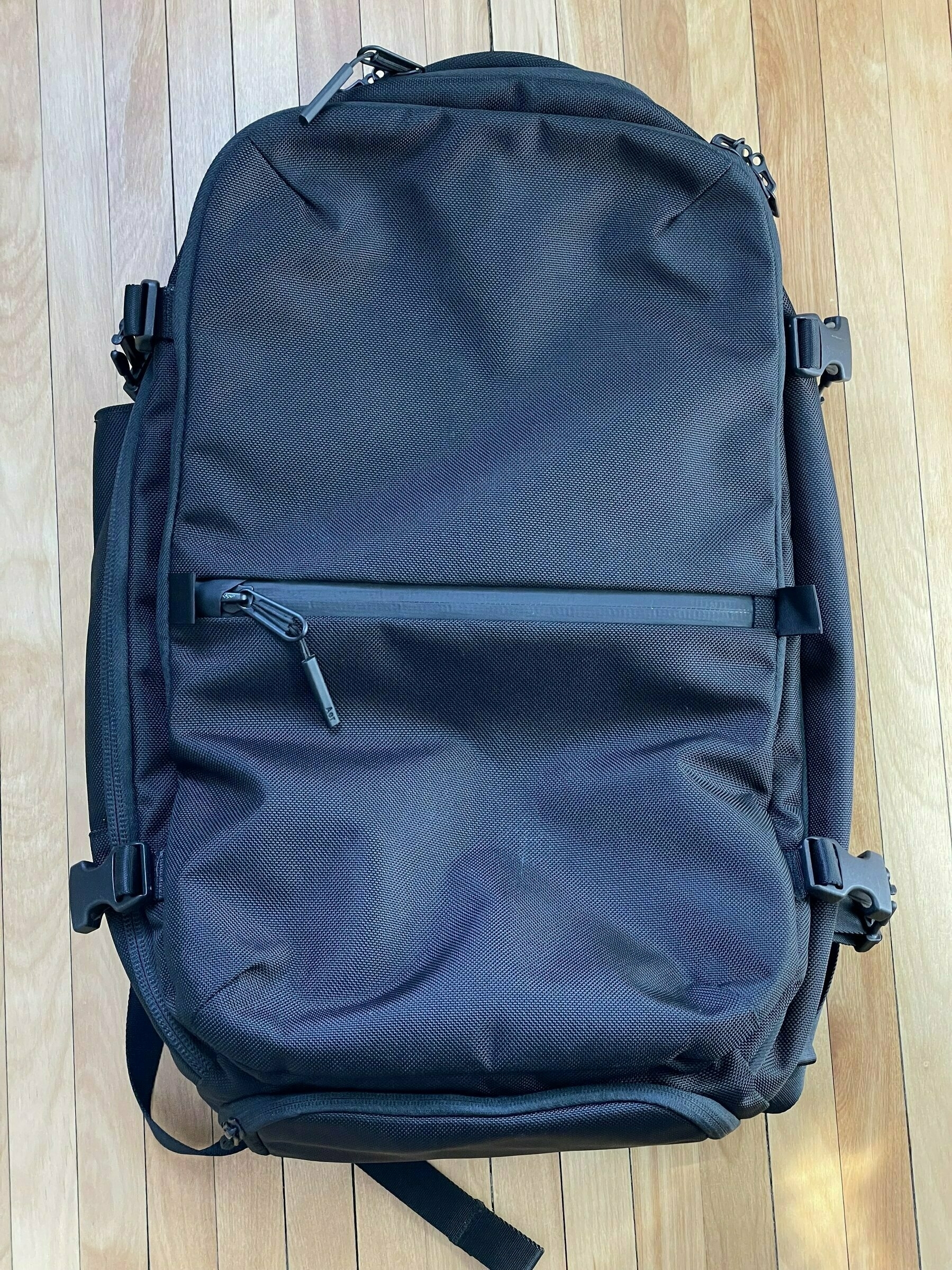
As usual, I spent an inordinate amount of time researching my options — and there are a shocking number of options. No longer is the technical material/hardcore design/one-bagging niche a small industry anymore; from my pattern of research, it's massive. There are dedicated bloggers/vloggers, endless kickstarter projects or post-kickstart projects that grew into huge successes, there are niches within niches, and there is shortage of intricate viewpoints on what the preferred array of attributes should be, from size, capacity, opening style, pocket placement, zipper pulls, weight, shoulder strap padding, grab handles/locations, on and on, it's overwhelming. I knew this. You probably knew this. But I continued to research anyway.
Good news, I have a few perspectives on this subject, and in particular, the subject of this review — I selected the Aer Travel Pack 2. Curiously enough, about 6 months later, I'm selling this bag to double-down on the Evergoods CPL version 2, but let me not get ahead of myself. The Aer Travel Pack 2 is an excellent, satisfying choice for being a de facto one bag solution for travel. Let me tell you why.
Capacity
At 33 liters, this is a few liters short of many similar-sized "carry on" backpacks in the space. Usually you see 35L or 40L. 45L seemed to large, and even 40L was pushing it. 33L is a sweet spot. If you can't set yourself up for a week's travel within the confines of 33-35 liters, you're doing it wrong.
I comfortably fit two loaded Tom Bihn shoulder bag packing cubes, a Peak Design small travel cube, Tom Bihn grab bag (for toiletries), a tech kit, extra batteries, notebook, hardcover book, MacBook Pro, and iPad 11 in in there without a problem, and had plenty of room to cinch the bag with its compression straps. This is my usual 3-4 day load out for work travel or personal travel (in autumn/winter months, given weather conditions), so if it can be accomplished in the bag, we're good. As part of this experiment in using this larger bag, I also had been packing a Tom Bihn briefcase rolled up so I could deploy as my laptop bag upon arrival. This system works well, since you do not want to lug the Aer around as your daily bag upon your destination — it's too big for that.
Material & Build Quality
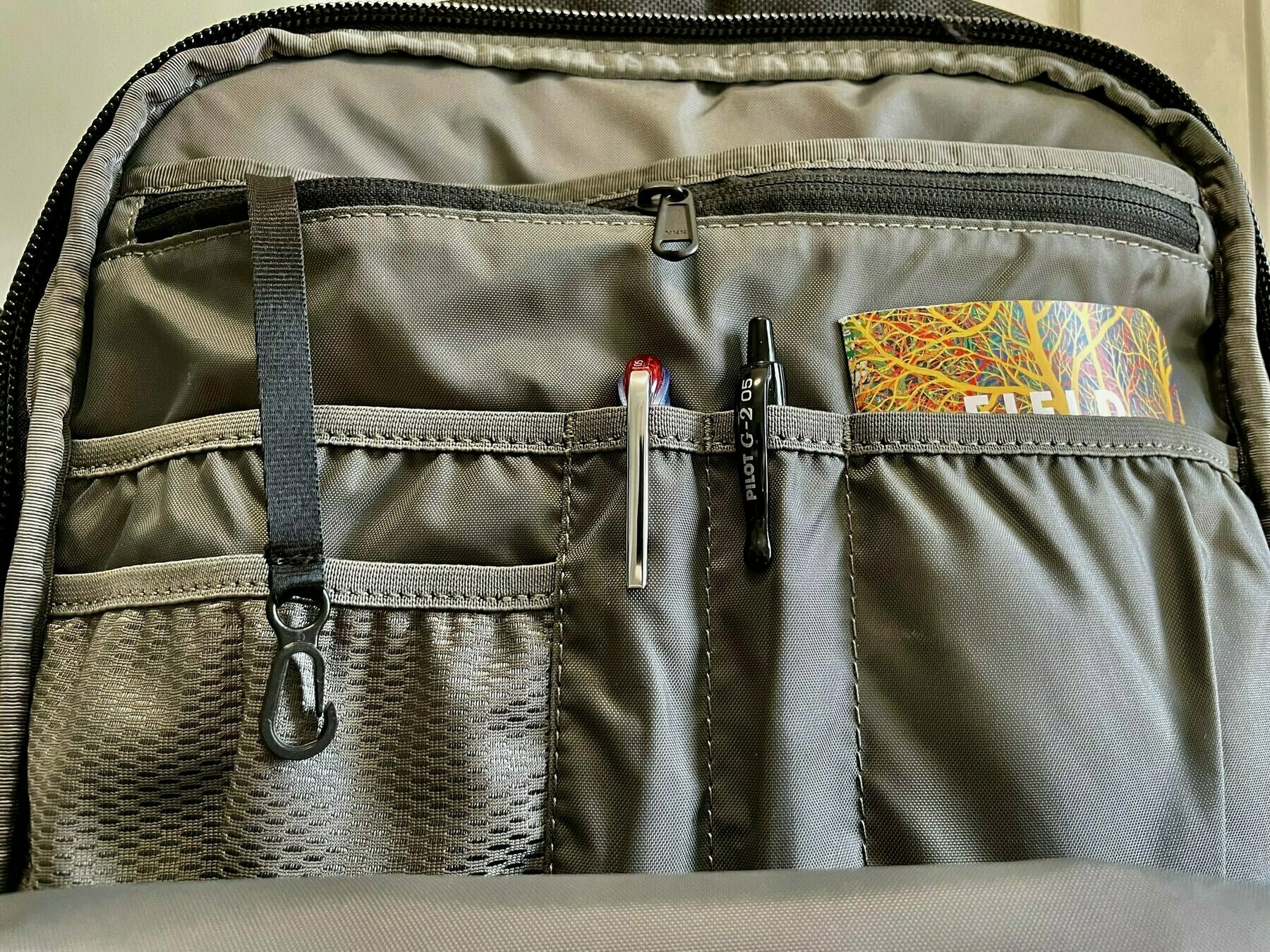
This is an Aer bag, so you likely know what to expect if you've seen or used their hardware before. It's a very sleek, slick, tough ballistic nylon exterior that deflects lint, pet hair, and debris of any kind. Inner materials and organizing pockets are the same cookie-cutter layouts and style from other Aer bags, but that isn't a bad thing -- it's functional. And there are plenty of pockets and places to stash your stuff.
The best, most thoughtful pocket is the top "access" one right next to the primary handle. The worst, most disappointing pocket is the outer-lower pocket that defines the middle zipline when facing the bag. Another disappointment is the pockets lacking their own capacities. Once you have the luxury of pockets offering individual capacities in Evergoods products, it's hard to adjust to anything but.
Lastly, the zippers are chunky YKKs, and they rule. Aquaguard ziplines on most of the main openings.
Clamshell & Compression
The bag opens clamshell, like all good travel bags (or honestly, EDC bags). So, like a suitcase, if you've never used a bag like this before. It's the best way to load and organize your carry. That's all.
This bag also has compression straps to either shrink the bag for lighter loads (dimensionally), or to shrink down a fully loaded bag. This is both a blessing and a curse: the straps look great and work great. They also block the primary zipper for the body of the bag, requiring you to unclip the straps every time you want to open the main contents of the bag. They do not block the laptop backpanel pocket or the slimmer external front pocket, though, which is a nice design touch — this lets you grab pens/books/notepads/computer/whatever you store there that you might easily need access to while on the go and not at your hotel yet.
Carry
The Aer Travel Pack 2 carries like a breeze. It's very cushy, airy, and uncumbersome for most medium-to-heavy loads. I never tired of having on my back, and didn't bother buying the harness straps (though I do realize it's the smart thing to do for heavy loads). I'd say it sits normally on your back — you don't need to ride it high or do anything special. Just toss it on your back.
Final Thoughts
I really enjoyed using this bag. If I wanted to continue going down the route of one-bag, one trip, screw the luxury of more than 33 liters of space, I would never stop using it. But the siren call of a different kind of load out kit for traveling overrode my enjoyment of the one bag dream here. I have slight regrets in selling it, but at the same time, have no restraint in telling you that it is worth getting if you're stuck on deciding whether to go with this or the plethora of other (probably also good) bags out there, like Peak Design's 45L Travel Bag, the Pakt Travel Backpack, the Nomatic 40L, Evergoods Travel Bag 35L, Tom Bihn Aeronaut/Techonaut, or the Minaal Carry On. This is elite bag culture bullshit, sure, but I did my homework, and there you have it.
Garden Fresh Tomato
We struggled to grow tomatoes this year, namely because we were out of town for several weeks and didn't get a chance to properly water the gardens, and secondly, it's been insanely hot. I'm no expert, but I'm guessing these two factors played a role in us not getting great traction.
But pseudo-roma tomato made it through the summer heat and smoke from the Canadian wildfiles. Just look at that precious little baby. It stood out amongst the still-green cherry tomato plants surrounding it -- notably, plants we didn't intentially grow, but must have ressurected themselves from last year. At any rate, this particular tomato looked ripe and ready to be consumed, so I picked on the way in from walking Gertie this morning.

I was tempted to eat it fresh and raw, something I love with cherry tomatoes (washed, cut, maybe a sprinkle of salt), but I had a blob of mozzarella left in the fridge, so I soiled the perfectly clean looking plate of tomato slices with that, salt, pepper, olive oil, and black balsamic.

It was good.
Pioneer Wallet - Molecule Card Holder Review
Pioneer has been building a special materials series of wallets since 2016, which is right around the time minimal wallets were hitting their stride. This was apparently a year before Trove released their seminal ultra-thin stretch/leather wallets, which have been a preferred champion for my usage over the years. But the material, thinness, and a year of COVID-19 (lack of need in using a wallet that can accommodate a lot of cards) had me tempted enough to order the Molecule Card Holder version from Pioneer. And I'm glad I did.

The premiere technical material blends that Pioneer uses for every one of its diamond-patterned wallets are the elite differentiators:
10DX
- DX10 is a their "custom blend of UHMWPE (ultra high-molecular-weight-polyethylene) and nylon"
- The build here is a very strong ripstop, with a notably tight weave that gives off an agreeably slick finish
- The entire wallet is, as a result of this, waterproof and machine washable
- Pioneer claims that the wallet will not noticeably "fatigue or age" for the first several years due to its manufactured process
- Available colors limited to onyx, black/white, and blue/white
3PN
- For the wallet I ordered, this is the materials blend I got with the Slate color (this blend is also available in Evergreen)
- This is a three-ply nylon ripstop fabric, featuring a DWR (dirt and water resistant) coating
- Since 10XD cannot be dyed in solid colors or achieve a fully dull/matte finish- 3PN helps us maintain our standard of durability and longevity while allowing us to offer limitless solid colors and a matte finish
- As with 10DX, 3PN stronger than other wallet materials (e.g., leather), it's waterproof and machine washable, and "woven to last a lifetime"
All of Pioneer's wallets have a 10-year warranty (which is incredible seeing as how many wallet companies don't bother with such a thing, though it pales next to Saddleback's 100 year warranty). Part of why they likely offer such a warranty is that their wallets use a stitching methodology they call FutureForm, which is a heat-fusing tech that "helps to reduce stitching and give [their] wallets a premium leather-like hand feel." It's geniuine, and it makes a huge different compared to other stitching in technical material wallets out there.
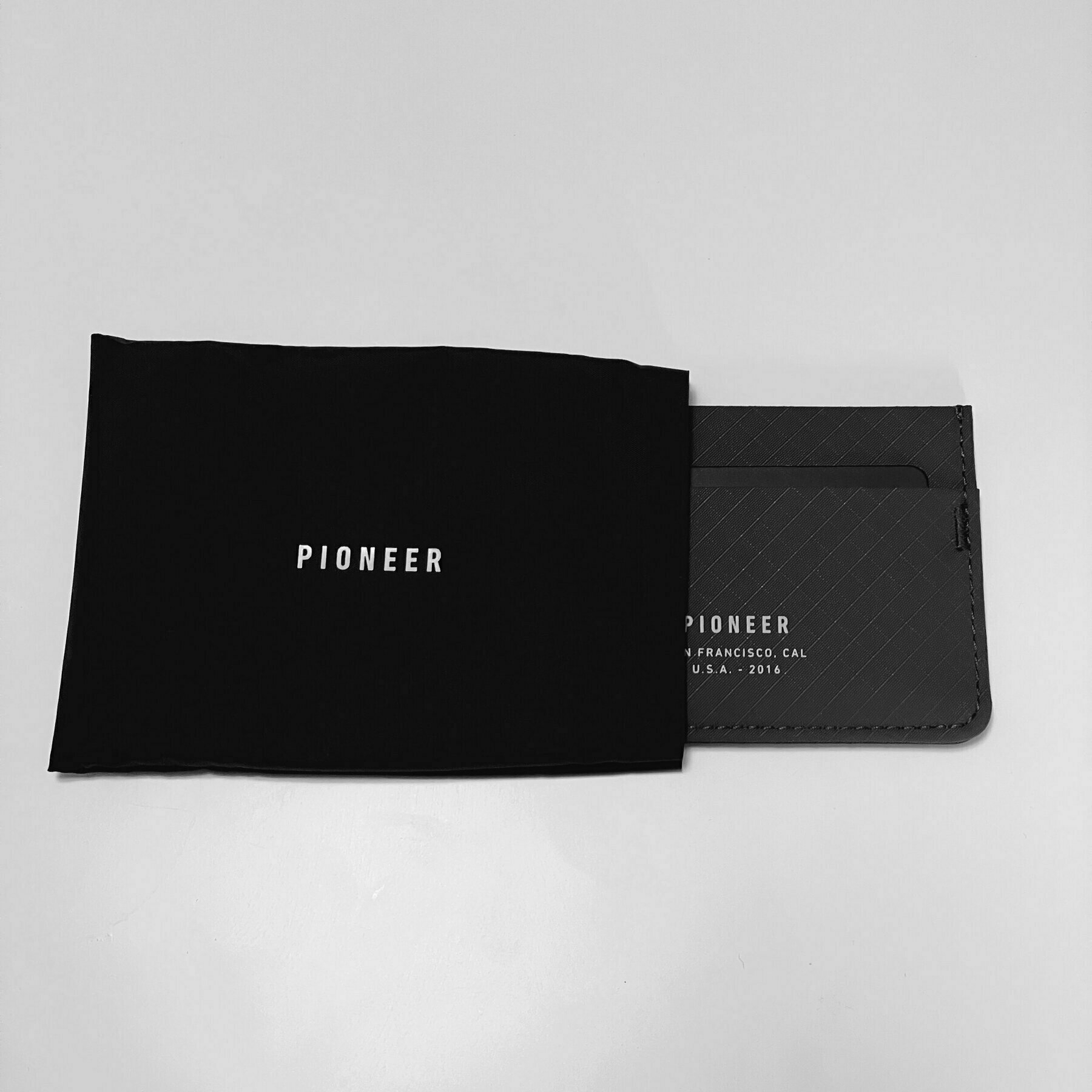
Overall, there isn't much to criticize. The everyday feel, thinness, and holdability is phenomenal and enjoyable. The three pockets (two short cuts on the outside, one primary deep pocket in the middle) are more than adequate for the number of cards I typically have on-hand in a modern, post-COVID environment (e.g., credit card, license, and debit card -- maybe a couple bills). It barely increases in girth when this load-out is in there, though it will of course get thicker the more you put in. I'd make the argument that this wallet could have a smaller overall footprint -- as you can see in the accompanying photos, it's a good 2cm larger than a typical card footprint. Perhaps this is by design, as a single folded US bill fits neatly into the main middle pocket (and would not/does not on wallets that conform to the exact size of a credit card, like the Trove). But even at its slightly larger size, it still pockets with ease and with minimal heft.
Without anything loaded in, the Molecule Card Holder measures 107mm x 74mm x 4mm, and weighs in at just 28 grams. Pioneer claims this one will hold 4-6 cards comfortably, but they have other wallet options for greater quantity needs. It's at once unremarkable to look at, with mostly hidden features, and the diamond-patterned shell is subtle at best on the 3PN color variants. But its shape, thinness, and extremely lux durability once touched immediately change your perspective.
The Hyper Key Solution for Mac
The beauty and efficiency of keyboard shortcuts has mostly eluded me. While I've memorized native application shortcuts, and created a few dozen automatic text replacements in System Preferences, I never went deep on customizations.
One fine day, I decided to try Keyboard Maestro, a much-loved automation application for macOS by the developer community. I didn't fully grasp everything it could do, but I started to see the depth of programming often-conducted behaviors or maneuvers in my day-to-day work stream. All without having to learn AppleScript or another programming language – understanding sequential boolean operations is all that's needed.
So I set up a few things that would help me establish processes like taking faster notes (foundational templates), open certain folders with hotkeys (to speed up file extraction/sharing), and do basic copy/paste work streams. More recently, I started seeing talk of this elusive "hyper key", which essentially is a way to map together all the modifier keys (command, option, control, and shift) as one holistic global key modifier. By doing this, it safeguards against interfering with other native applications' keyboard shortcuts and regular global modifiers. By virtualizing a hyper key, you get a fifth modifier key to rule over an entirely new set of shortcuts and automations. The trick is assigning this string of keys to a single key not currently in use.
Given that the F-keys are tricky to string together in a physical stroke due to their location on the keyboard (and harder still if you have a MacBook Pro with the Touch Bar), the obvious key to employ is the under-used Caps Lock. It's surprising this key still makes its way onto every keyboard layout – aside from easing the typing of serial numbers, legal agreements, and maybe labeling diagrams, it seems entirely anachronistic. I did some Internet sleuthing, and arrived at a number of ways to deactivate the Caps Lock key's primary operation and remap its usage. Upon perusing said search results, there are quite a few others out there who not only thought the same thing, but have built a myriad of instructions and even apps to accomplish this.
The Hyperkey App - a Review of Sorts
If you don't want to screw around with the more technical elements of this remapping operation, I suggest giving Ryan Hanson's App, Hyperkey, a try. He charges $5 for it, and makes a compelling argument that it might just be easier to have a simple method for remapping Caps Lock instead of the lengthier process of downloading Karabiner-Elements (albeit a more expansive keyboard customizer for macOS):
My goal with Hyperkey is to maximize a human performance gain while minimizing configuration and OS impact. Despite pre-existing solutions to this problem, I still can’t help but gravitate toward Hyperkey and this goal. This app has also been an initial testing ground for two ideas: Swiping one touch from the trackpad edge as a key press, and finding the simplest ways to remap keys.
Since I wanted to go the simple route, and use it with my already-paid for Keyboard Maestro, I threw five bucks at the situation.
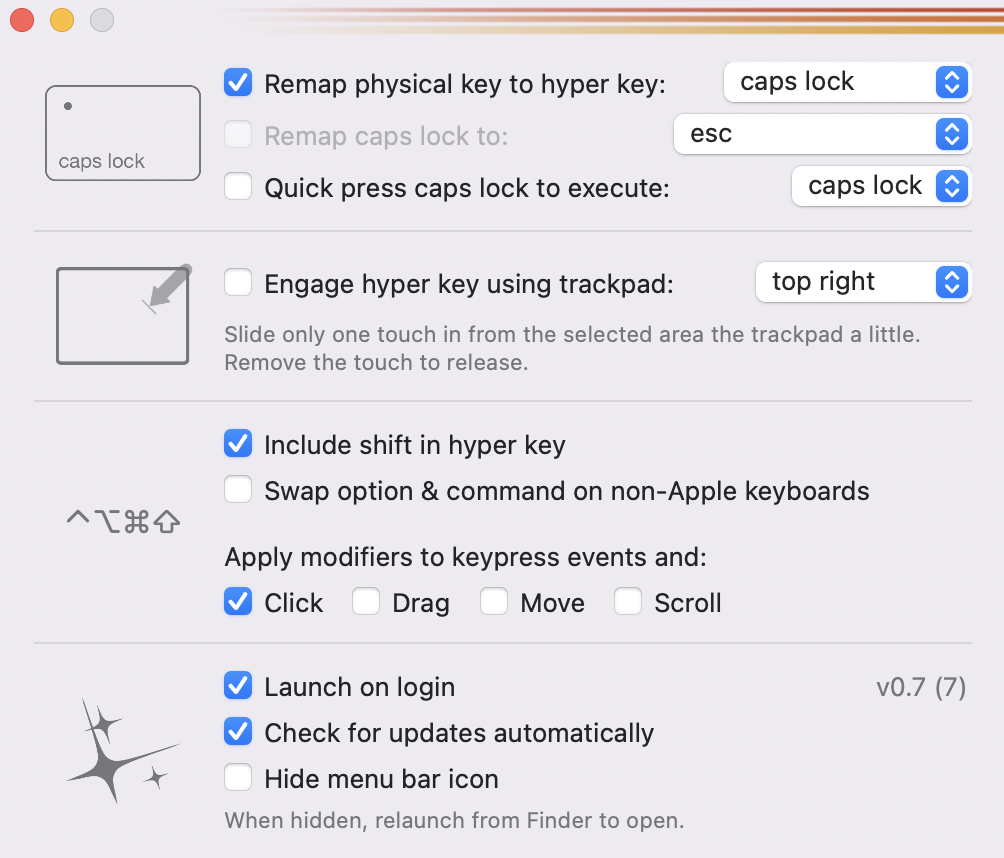
Good thing, because it works phenomenally well. I've already built what many will likely find basic operations with the hyperkey, but have tremendously streamlined getting going with work in the morning and getting work out of the way for the evening and weekends, including:
- Setting Amphetamine to a session duration to kick-start the day
- Opening work-related apps in the morning in my Desktop 1 Space (work) environment, like Outlook, Teams, Notes/Bear, work-specific browser, etc.
- Closing work-related apps and shifting the view to Desktop 2 (personal Space)
- Note-related templates that automate day/time and setup sectional structure for attendees, scratchpad, to-dos, etc.
I'm sure several more ideas will come to me, but even these in their simplest form, have been huge time-savers.
And while I haven't figured out a good use-case for this other option the developer included, it's worth noting:
...the checkbox for swapping option & command for non-Apple keyboards. This is actually the one other item that I have desired out of a key remapper, since the built-in macOS functionality is frustratingly laggy on one of my Microsoft external keyboards every time my mac wakes. I couldn’t help but add this in.
If you want to easily make much better use of the Caps Lock key, Hyperkey is a great gateway into allowing for a super-modifier key to pair with other more robust keystroke automation software. Who knows, maybe it'll work with the new Mac Shortcuts coming in macOS Monterey, too.
Western Rise - Apparel Review
These past several years, I've been bouncing around a few technical-fabric apparel brands, seeking well-built, solid uniforms with thoughtful quality materials. It hasn't been difficult to find dozens of niche brands filling this space. But only Western Rise has fit the bill perfectly across all components of a minimal yet complete wardrobe.
My first foray was with Outlier, a New York brand drenched in radical ideas for hardcore fabrics, construction, and style. They've gathered a cultish following over the years, and their product line has ebbed and flowed, most dominantly from their iconic set (merino wool tee with slim dungaree pants), to such wildly idiotic inventions as the strongwool hide. Their pants are great. Their shirts are inventive (I really like my ramielust tee for summer temps).
I also dabbled in Ministry of Supply, whose mantra is maintaining an inventory of manageable clothing backed by science. So instead of referencing various ways of washing specialty fabrics (like Outlier), Ministry of Supply focuses on machine washable approaches to everything, even though they are heavy on technical, breathable fabrics. I picked up a great merino tee from them a few years ago, and have been sporting their perfectly-designed kinetic blazer for work/travel.
The brand that has aligned with my clothing preferences the most is an outfit out of Colorado called Western Rise. Their color sets are simple and consistent (blacks > blues > grays > greens), their catalog is tiny, but thoroughly meets the needs of a weekly and multi-functional uniform, and the fit of their clothes is better than anything I've had ("tailored," but comfortable).

Over the last year, I've picked up a few staples that have dominated what I wear day-to-day:
This was my first Western Rise purchase. I went for blue gray, a color perfect for matching the rest of their color spectrum.
Right off the bat, these things fit wonderfully, true-to-size (they run S, M, L, you can target a size accurately since they have a cinched waist). Their 4-way stretch is incredibly pliable, the comfort is high, and the water/stain resistance is a major bonus. And as with most (all?) their products, they've very breathable, which makes them suitable for spring/summer wearing in the heat, and function stellar for things like kayaking (with quick-dry properties). The primary pockets are massive cavities, which is in most cases a good thing, but I tend to use the left-leg zippered pocket for my iPhone since it sits awkwardly in the larger primary pockets. The cinch tie and zipper pull on the side pocket are capped with tightened wax, which is 🤌.
The range you can get in these is incredible. They look nice enough to go out for a drinks, flexible enough to work out in on a cooler day, and comfortable enough to WFH in (or, sure, work in the office). I'd buy more, but this one works so well and resists the need to wash frequently, the value of one is more than enough.
This jacket is brilliant. It's super light-weight, comfortably manages temps anywhere from 30 Fº-55 Fº, has great side-slit pockets + a hidden inner zipped pocket + chest-flap pocket, and the fit is superb. Somehow you can manage to wear a tee, sweater, hoodie, or any combination therein, and the jacket doesn't constrict with the layers. Perhaps it's the leeway in stretch, perhaps it's just magic.
I've been wearing this non-stop in Minnesota's wildly fluctuating spring temps, and haven't had to break out a rain coat or a winter jacket for any of it. The AirLoft Shirt Jacket is a great use-case for this weather spectrum.

This truly functions like their claim — it's the jean "re-imagined". This one does a better job of feel/fabric mimicry than Outlier's Slim Dungarees (and has less of the slick-feel, which, depending on what you like, is a positive or negative). The AT Slim Pant does have a minimal technical fabric noise as you move in them, but it's part of the deal.
The fabric is heavier in the sense that it is more substantial than the other pants I've worn from Western Rise. It's not a heavier weight, but it feels more rugged, durable. These can take a beating. Like jeans.
A few bonuses to this vs jeans is that they are much more breathable, have a two-way stretch (which, admittedly, isn't obvious), and they also are water resistant (tried it, and it's an accurate claim). They also claim stain resistant, but I haven't had the accidental pleasure of running into issues there yet.
The one thing I've noticed about these and the Diversion pants are that they have some curious pockets. Main side pockets are great, completely adequate in size, and both have the "fifth" mini-pocket that isn't so mini on the right-side — it luxuriously fits an entire smartphone (iPhone 12 size tested here). While great, a fully-lined device in that pocket does constrict hand volume in using the primary pocket. Additionally, they have a secret zippered pocket on the back-right side, which is kind of a meh for me, but could be a blessing for others who still put a wallet in their back pocket. I could see sticking a $20 in there, and no one would be the wiser.

Extremely comfortable material (I'd argue even smoother, stretchier than the Spectrum Joggers). This is close to a default pant to wear day-to-day, but my only point of contention is that they run tighter and stiffer at the waist compared to the same waist size in the AT Slim. It's almost enough to encourage a size up.
Other than this, it's a near-perfect pant. Probably most suitable for an everyday chino/jean replacement, will operate as a great travel pant, and can be dressed up or down. As noted, it's got the 4-way stretch that adds immeasurable comfort to the wear and movement. Same water/stain resistance as you'll find in nearly all their products, and it's similarly breathable. It's been fine in cooler temps, and while I haven't had it for warmer months yet, if it's anything like the Spectrum Jogger, it'll be perfect. Cold sub-zero days may require a switch to the AT Slims.
Limitless Merino Button-down Shirt
I continue to wear a few really functional button-up shirts from Bluffworks, so there was some hesitancy in trying a new type of travel-worthy, wrinkle-resistant button-up/down shirt. Of course, I'm glad I did. Western Rise's take on this is great, starting with the differentiated material. Instead of Bluffworks' 94% polyester/6% spandex blend, we're talking nearly full Oxford knit merino. It has a welcome multi-way stretch, breathable material, and is surprisingly light-weight. As with nearly all merino, the material resists odor for days, meaning one may be all that's needed for a quick business trip.
The shirt design looks classic, fits tailored, has collar buttons for slinging a tie through if needed, one breast pocket, and doesn't run too long, so you can tuck it or wear it over the pant line, no problem. Bonus: these pack very tight, so there isn't much additional volume added when traveling minimally.
The only minor grievance I have is that the lower button on the two shirts I've got has a tendency to undue itself. This is hardly a complaint, but something I've noticed in the daily wear. It's probably my fault 🤷♂️.
Hunting the best tee is a never-ending quest. I’m happy to report that Western Rise has a formidable contender in the Cotton X Tee. Solidly constructed, heavyweight but stretchy as hell, and magically odor resistant (tested for several days), the this thing over-performs. The blend is 60% cotton, 35% polyester, and 5% elastane, creating a sweat-wicking, quick drying material that is pleasant on the skin and hyper-wearable. If I could only wear these every day, I would.
The merino tee is a much sought-after holy grail of shirts. While I haven't had the opportunity to try many, the travel/minimal packer/one-bag scene is ripe with recommendations that merino is the only way to go. Odor resistant, strong fibrous weaves, super soft feel, quick dry properties — this is what merino aims to provide. If you're only able to fit one or two shirts into your luggage, make it merino.
Western Rise's product here is good. It's an 18.5 micron single jersey cut, which means very breathable, very light, and dial up or down on keep you warm/cool depending on the weather. The fit is a tad looser than the equivalent size in the Cotton X Tee, which may just be the way they've decided to code this due to the fabric. It also runs longer than your typical tee, but drapes nicely. The length doesn't make a ton of sense to me, but I suppose it works well depending on your torso, and it should be noted that there's a decorative cut on the sides that adds some dynamism to the composition.
Overall, this works exceptionally well. The quality is high, it packs insanely small, and it'll probably last a long time.
~ 👔🤑👖~
If you're interested in trying Western Rise, you can get $20 off your first purchase — here's an affiliate link (full disclosure) to do so:
Otherwise, simply check out the site with any of the product links above. You can even try at home for $0 with their Try Now integration.
Good stuff.
Zipper Pulls
A fleeting thought about zipper pulls -- the kind that are either natively part of your bag, purse, dopp kit, etc., or those that you add on to an accessory because the native one sucks.
The more I enjoy bag construction and the meticulous materials, fabrics, and fastening devices used to build them, the more I scrutinize zippers. Mainly, I've come to to the conclusion that any zipper that rattles isn't fit for use, all security measures aside (way better to fasten locks against metal zippers than other materials). Trust me, once you've eschewed metal-on-metal clanking, there's no going back.
Goruck bags were the first experience I had in quiet zipper pulls back when I got my GR1 in 2012 (which, by the way, holds up perfectly to this day, nearly a decade later). They use YKK zippers with pulls constructed from parachute 550 cord and heated wax tubing that. They're amazing, and hold for a quite a while. I've only had to update one of them because the burned knot unraveled.
I've rarely seen completely silent zippers deployed anywhere else on the gear market, but you can turn any rickety loud zipper into a silent one, and use any kind of zipper pull you want, with a simple tool -- this (or others like it) will allow you to clip the metal/loud plastic zipper pull for removal. Just loop any other zipper pull to the main fastener of the zip itself, and you've engineered a better zipper.
A few recommendations of zipper pulls that work exceptionally well:
[Alas, Goruck no longer sells their paracord + wax tube kit for making your own Goruck zippers, so you'll have to scrounge those materials together in your own way.]
Update:
Speaking of zippers... just happened to come across this piece on the dedication to quality from the Japanese zipper manufacturer, YKK. YKK zippers are simply the best, and you’ll know it right away when you pull them.
Of note, “...what makes YKK zippers so good:”
- Square-tooth technology that ensures smooth, reliable zipping
- Self-locking design that keeps the zipper from unzipping itself
- Self-lubrication that keeps the zipper working well
——
Because I seemingly write about zippers now, thought I'd share a re-threading of two YKK interior pocket zipper pulls inside my Evergoods Civic Access Pouch 2L (which, by the way, is a phenomenal organizer).
There was nothing wrong with the original pulls, but they were metal, and you know me. I clipped them and replaced them with DSPTCH's zipper pulls, which were the perfect size. They don't really hang over the edge and cause any issues with the main closure zipper, they're black and mesh nicely with the interior vibes, and they're now noiseless. 👏.
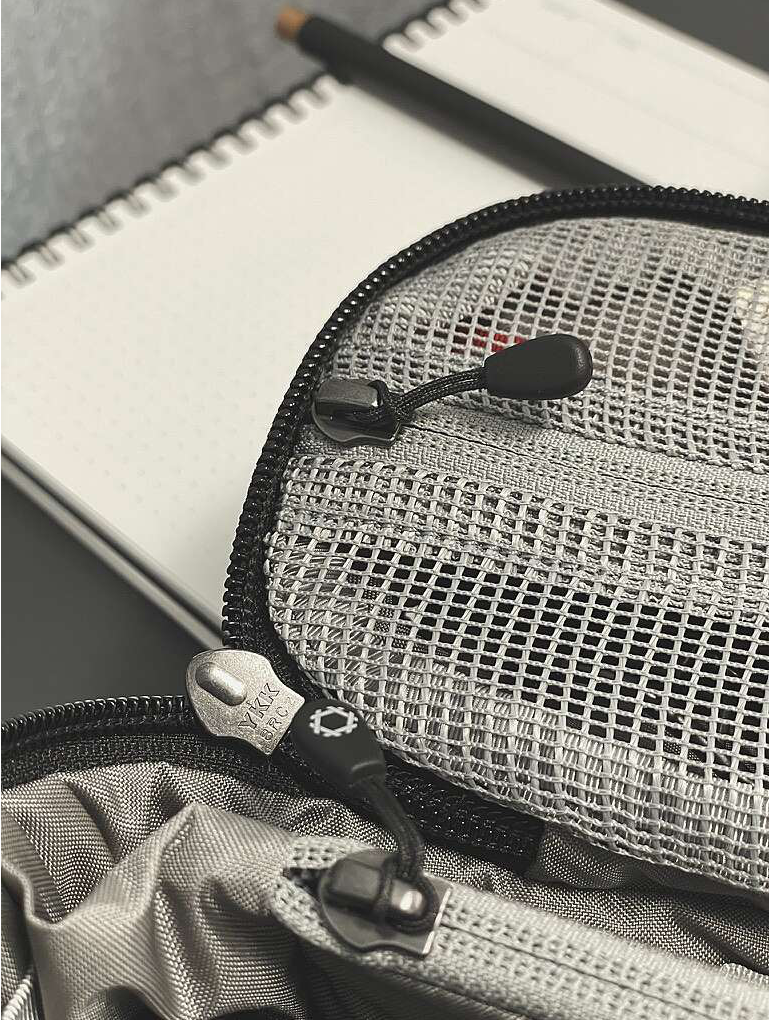

Updated Take on One Finance - Two Months In
In a double-whammy, I've updated initial thoughts on my experience so far with One Finance + conducted an initial post on HEY World, the HEY email client's new, simple blogging platform.
Democratized Technology & Its Empowerment of the Predominant Headline Narrative
After reading Jessica E. Lessin’s “What Critics of the News Industry Get Right — and Wrong” essay, it prompted me to return to the subject of modern journalism and the media companies it’s intrinsically entangled with.
Democratized technology is beneficial to society in that it enables citizen reporting, fast dissemination and syndication of stories, encouraging a community of discussion and commentary, and — essentially — building a voice to the oftentimes voiceless in broader media contexts. It has been discouraging to the practice of journalism, however, as old world news media companies have taken a backseat in the generally recognized idea of news. They instead seemingly have to play on the same service distribution level with any layperson or other potentially “untrusted” institutions on Facebook, Twitter, TikTok, or YouTube. In a similar fate that has been wrought upon restaurants with their use of middle-platforms like DoorDash and UberEats, the direct connection to readers and their attention is now shared and competed for based on the sites, platforms, and apps they’re defaulting to (as opposed to visiting the nytimes.com or a restaurant’s site directly).
This permeates everywhere — what once was curated radio now competes on the same technological battlefield as sophisticated video and audio podcasts, distributed by citizens as well as upcoming media empires. It is generally a good and progressive thing to see this, but all of media is now predicated on limited attention behavior and exploitation of headlines and interfaces to propel engagement. And that is where we are seeing the fabric of journalism unravel, along with the bull rush on misinformation.
Lessin suggests “services should create tools and establish norms for disclosing conflicts of interest and encouraging questions from attendees.” That’s a fine approach — arguably a necessity. Twitter and YouTubr have done uneven jobs of this lately, but they’re on the right path for its inclusion in the platforms and trying to make sense of terms of service expectations so as not single out any specific person or behavior, but to create parameters around which we must use the platforms to their appropriate specs.
We inevitably get into misinformation territory when talking about this subject, and that’s where I have my concerns — not necessarily opposing opinions - to what Lessin states next.
The general idea is that platforms should allow people to get context on what they are hearing from public figures on new platforms.that should be baked into the culture of the products, not included as an after thought.
This isn’t wishful thinking, but it is a byzantine challenge of implementation, because it will now need to be an after thought for primary services and media platforms. And it’s not just about providing context for public figures and what they say — it needs to be equally applied to journalists, opinion columnists, and citizen reporters. In this sense, I don’t see it happening on a scalable way any time soon.
Outrage news, predominant headline narratives, and surgically edited sound/video bites will continue to dominate platforms and media sites because the inherent nature of readers and watchers is, again, predicated on limited attention and infinite scroll exploitation. We still live in a quick bites society (post character limits, meme storytelling, sub-1 minute video/audio clips), oftentimes out of context, and without a pragmatic, scalable ability to clarify any of it. The ability to link to more information (as in, use a sound or video bite as the attention grab, and link to a fuller essay or report) is one way of handling this, but that’s like mixing memes with textbooks — you came for the memes, you don’t want to read a book explaining them.
Lessin ends her essay with a note about how we should be concerned with how “[these services] will be manipulated by a few very powerful people in the future.” We’ve already seen this take place with mass misinformation dissemination in the political universe, but we also see it play out all the time in niche sectors.
Right now we are seeing Facebook sell a narrative about Apple conducting itself in an anti-small business way with an upcoming iOS update that simply prompts its users, upon opening an app, whether you want to allow the app to track you or not. This is a threat to Facebook’s advertising livelihood in how it conducts its business, but the predominant headline narrative is against the gatekeeper in charge of distributing the Facebook app. Alternatively, Apple has created a narrative about being the do-gooder in the tech space and advocating for privacy controls that do not impact its bottom line. Apple (and many privacy-forward internet browsers and content blockers) believe an end-user has the right to choose when they are tracked and how they are tracked. Without studying the intricacies of the situation, which require more than a quick bite of information, a reader may not understand the full context, jump to assumptions based on predominant headline narratives, and move on.
So if we are making an argument about media service companies needing to label and fact check, shouldn’t we apply this same principle to every scenario imaginable that could manipulate or persuade an end-user? Is that possible? Is it the right thing to do? We are entering a slippery slope with attempting to regulate major tech services and platforms, which in one way makes sense only to help clarify concerning headline or misinformation trajectories, but on the other hand, endangers the very democratic principles that allow us to communicate freely and openly with one another, including the evolution of citizen reporting in places normal media and journalist outposts have been unable to cover. A smart servicing layer atop these platforms, with accredited or blessed old/new world media institutions as the resource backend, could help with identifying topics and scaling additional reference material to compliment any kind of posting, sound bites, video reporting, etc. it would require coordination among tech platforms and an agreement to build an approved ecosystem that allows them all to scale it together in a consistent manner.
Without coordination and general guidance among these service platforms, I don’t see the challenge at hand being remedied in a competent way any time soon.
Switching Banks: Simple Bank to One Finance
[Includes updates after using One for four months; scroll to bottom.]
January 7th brought disappointing news to a small contingent of bank users in the US -- Simple, a clever fintech banking experience, informed users it was over. The email was blunt, pointing to BBVA USA (the current back-end housing Simple's deposits) as having "made the strategic decision to close Simple".
This was met with a resounding, gutteral sigh from several of us who had been around since the beginning days in 2009. According to the New York Times, Simple had acquired 20,000+ users and aggregated $200MM in transactions by 2013, likely catalyzing it to be acquired by BBVA USA in 2014. The draw of Simple was its experience -- thoughtful in every aspect, the bank was designed to be helpful to users managing their money. It set itself apart immediately from others in the space and, even to this day, has outclassed competitors in its holistic experience and feature set. (There is likely an obvious explanation why.) With Simple, you could:
- Manage checking and "protected" accounts (essentially savings) in an integrated interface
- View transaction-level data that has apparently been available to any bank forever, but no one cared enough to share, like time of transaction render and location information, and permitted editing vendor name, categories, hashtags, and memos
- Provided a programmatic envelope-divvying system in two ways:
- Expenses, which could be automated to align to date-specific goals that would expense out on a recurring basis (including completion tracking), and pull from direct deposits or other income sources to fund
- Goals, which could be set up ad hoc to dump money in, or aligned to long-term goals with manual/auto-investments daily/monthly to meet the target funding
- Safe-to-Spend, a calculated figure indicating the remainder in your available funds to use outside of Expenses and Goals
- Any transaction could also be aligned/tagged to these Expenses and Goals, allowing for even more organization around money flow and budgeting
- The beauty of this whole system was that it was native to the bank: Goals, Expenses, and Safe-to-Spend were all virtualized over a basic checking account. This was the magic of its execution.
Simple was, and will continue to stand as, the best banking experience ever designed. Alas, a good thing had to come to an end, evidently. When BBVA USA was acquired by PNC very recently, it came as no surprise Simple was getting shuttered. It competes directly with PNC Bank's other products, and likely interferes with brand building. We'll assume the acquisition was userbase and assets.
And so I, like many others, have been looking elsewhere. The banking and fintech landscape has changed significantly in this past decade, but seemingly has not changed much at all in what's uniquely on offer for banking solutions. An influx of new, flashy banking brands have cropped up in much the same way and variety that millennial DTC brands have been bootstrapped through Red Antler's identity marketing program. That includes the omnipresent Chime, but who offers few value propositions aside from early paycheck deposits (like many others now) and, at this time, a decent APY on savings (0.50%). But their fee-free and overdraft-free account programming isn't anything revolutionary. Many have this now. And it's not compelling enough to switch a discerning Simple user.
I've spent a good deal of time scouring Reddit, fintech industry sites, and Twitter to seek the best alternatives. There has been an enormous amount of other folks’ goodwill towards this research, and I'd like to point out one Reddit user in particular who has compiled a comprehensive comparison list of several alternative "neo-banks", alternative banks, and fintech software layers to traditional banking.
I finally found something that should work.
One Finance Review
In all, there isn't a direct replacement for Simple. Nothing does what Simple has done for years, and there's only one bank that comes close: One Finance. But first... there are a couple solid contenders that could evolve in the right direction:
- Envel.ai: has the smarts and the talent backing it, uses envelope-based budgeting as a core component, but the hokey, emoji-heavy aesthetic, and the questionable approach of surrendering your money to AI autopilot “learning” was discouraging.
- Astra: Impressive automation software that layers on top of banking accounts (using Plaid integration only for now, which prohibits some banks) primarily to permit the user to program the movement of money between institutions with instructions like "every two weeks move $from to __". This works, in theory, with any traditional bank you may use, and in practice, this might work for some folks, coming the closest to Simple's recurring expensive and goal funding. It falls short, however, in being a layer atop of bank (not native), not yet being able to recognize income deposits (e.g., paychecks) and then move specified money to the appropriate accounts (only percentage-based). You also can't assign expenses against labeled budgets once they’ve gone through, which was an intrinsic component of managing and organizing in Simple.
- Huntington: One of the national banks actually does feature some smart integration on saving goals and budgeting within its checking and saving accounts, including MoneyScout that auto-saves money from transactions (essentially a “round-up” based on spending habits and cadence), and Savings Goal Getter, a way to divvy up multiple savings buckets for things like vacations. While these could work as an alternative to envelope budgeting, they still don’t allow for the customization of a recurring or transaction-assignments methodology.
One Finance was appealing enough to try, and immediately made the most sense once inside the platform. A short summary of what works well and helps rationalize why I went with this alternative:
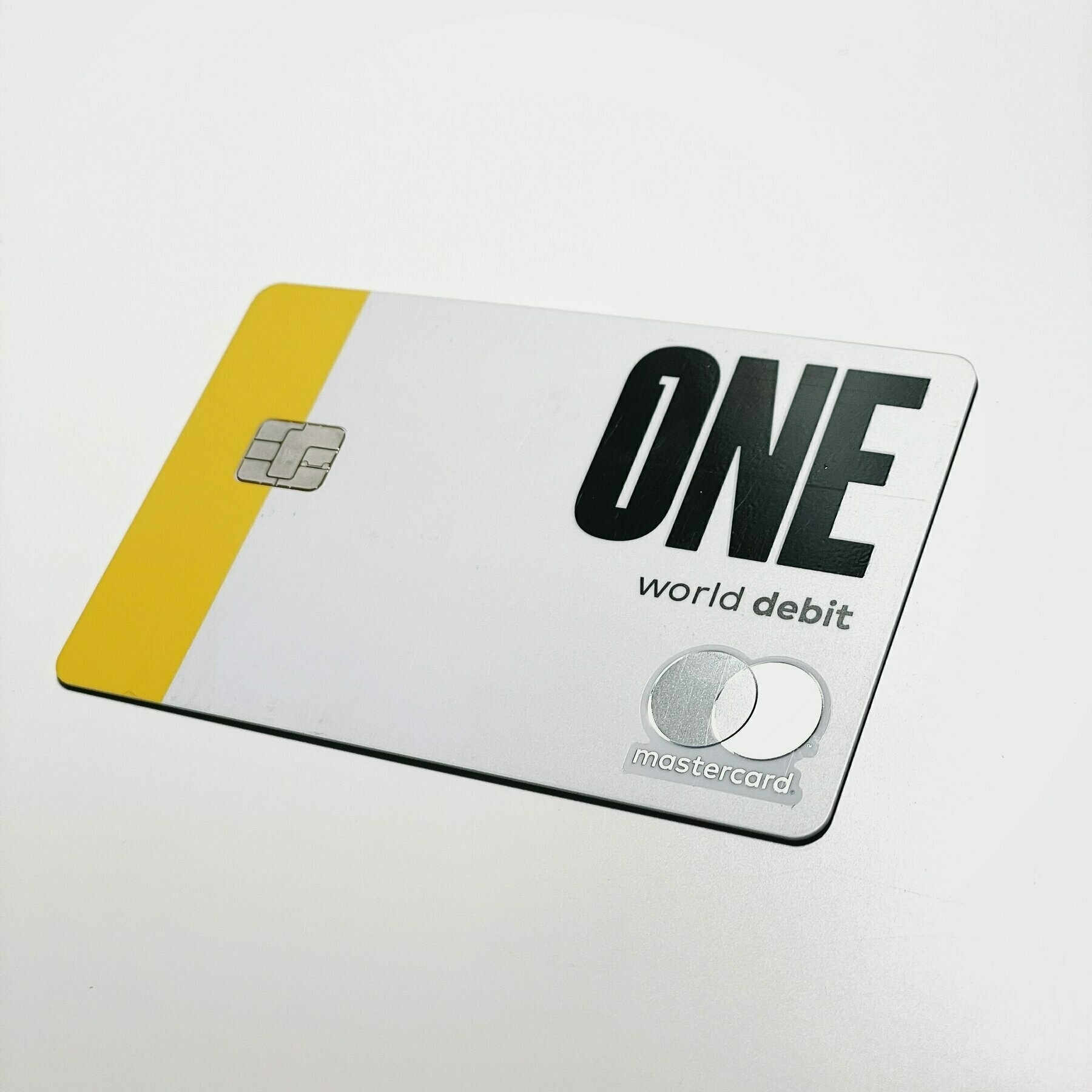
- Sub-accounts called Pockets operate as distinct money budget envelopes, with the bonus of having their own unique routing + account number (permitting secure, literal connections to, say, utility bills or investing accounts), and with the bonus of being able to share this with other users (say, your spouse, in an alternative to joint accounts)
- Auto-save (up to 10% of your direct deposit) in an industry-leading APY (3% at this time) or deposit into a strong 1% APY normal savings account (up to $25K)
- Ability to attach your debit card to any given pocket at any time, providing extra security and budget-conscious usage of payment structures (virtual cards coming soon)
- Uses Coastal Community Bank as the back-end, a small regional outfit in Washington. There have been guarantees that there's no intention to attach or sell itself to larger national banks that could wind up putting One in a similar situation as Simple once it was passed from Bancorp to BBVA.
- Incredible goodwill and outreach to the Simple and bank alternative community on the OneFinance subreddit. They've been adamant about intaking community feedback and ideas, and re-engineering their feature roadmap, including a priority of recurring fund movement into Pockets ala Goals/Expenses.
- Checks the other expected boxes of no-fee ATMs (within the Allpoint network), no blatant/overdraft fees, early paycheck deposit, round-up transaction to savings, and a low-risk credit line if these things are of use to you.
Overall, One Finance has an altruistic approach to banking, including a lot of the transparent, no-bullshit values that echo Simple's philosophy. It helps that quite a bit of talent leading One is from Simple (their CEO led Azlo, Simple's sister bank) and similar derivatives. It isn't perfect, though, and it has a lot to prove in the months to come in how efficient and capable they are in meeting their ambitious roadmap. It's missing a significant amount of core features, which is why I'd still recommend having a traditional bank as a contingency plan/hedge on needing to do "normal banking tasks". While several of these are on the imminent roadmap, One currently (Jan 2021) doesn't have check deposits, recurring funding of Pockets, outgoing wires, outbound cash app integration (only inbound), physical checks, data exports, search functionality, or editing transactions (categories, memos, etc.). They aren't dealbreakers if you can bear with the early stages of a company carving its way in an ultra-competitive industry, but time will tell if they can meet their lofty aims.
If you're interested in giving One a shot, try it via either of these links:
➔ Affiliate Link (if you're inclined -- you'll get $50 after an initial $250+ direct deposit set-up)
➔ Non-Affiliate Link to Sign Up
Four Months In - Update
Since I opened an account, I've had several direct deposits from my salaried paycheck drop in (it truly does come a few days early due to the way they pull the trigger quicker than normal banks' ACH acceptance + transfer), have created a handful of Pockets (their version of envelope-budgeting), and set up payment structures with utility companies and investing firms where credit card payments don't work.
What I like:
Pockets. Simple, but also complex envelope-budgeting. You can share them with any other One user, and each one also has a unique account number, meaning you can securely share these with various companies you want to pull money from without risking security exploits or access to your entire account's funds.
Savings. A savings account with 1% APY (at this time) is unheard of. And the way the auto-savings works (a separate account for 3% APY with a max contribution of 10% of all direct deposits) is both a brilliant way to encourage and retaining savings habits, but also an incredible savings rate up to $25K).
Engagement. The team has been highly active on social media and answering thorough questions and feedback on One Finance's subreddit. It's a promising sign from an early start-up.
The team behind it. Ex-Azlo/Simple folks are contributing, and there have been initial promises that One won't face the same fate as Simple with a sell-off to a large national bank. 🤞
A transparent roadmap. This is excellent to see, and reassuring they’re committed to evolving the product over time, like most great software is. Why should the banking experience be any different?
What I don't like (but know will probably be solved for in their roadmap):
Lack of transaction search. [I'm using Monarch in the interim.]
Limited recurring transfer feature (monthly or every week/two weeks just don't cut it for how this should work). Astra does a superior job of acknowledging a deposit amount and moving xx or xx% to a designated place, but is delayed and clunky by comparison due to it being a third-party method and the fact that our current banking infrastructure is slow and cumbersome.
In a recent update on their roadmap, however, they are tackling this in what they’re calling the to their Money Movement update. So again, fantastic to see this be addressed, and so quickly.
Lack of authenticator app-based two-factor authentication (they have installed 2FA via text messages, and will be adding step-up authentication this summer, which is great).
Overall, I'm pleased with the switch and look forward to its future. They've already made good on a number of short-term roadmap promises. Here's a raised glass to them rounding out the feature set this year.
➔ Deep reading being eroded by skim reading via modern child development
These processes include connecting background knowledge to new information, making analogies, drawing inferences, examining truth value, passing over into the perspectives of others (expanding empathy and knowledge), and integrating everything into critical analysis. Deep reading is our species’ bridge to insight and novel thought.
Just received my first book from Black Garnet Books, the recently-launched Black, woman-owned bookstore in Minnesota that curates contemporary literature from racially-diverse authors. And their online store is open for safe browsing/buying during the pandemic.
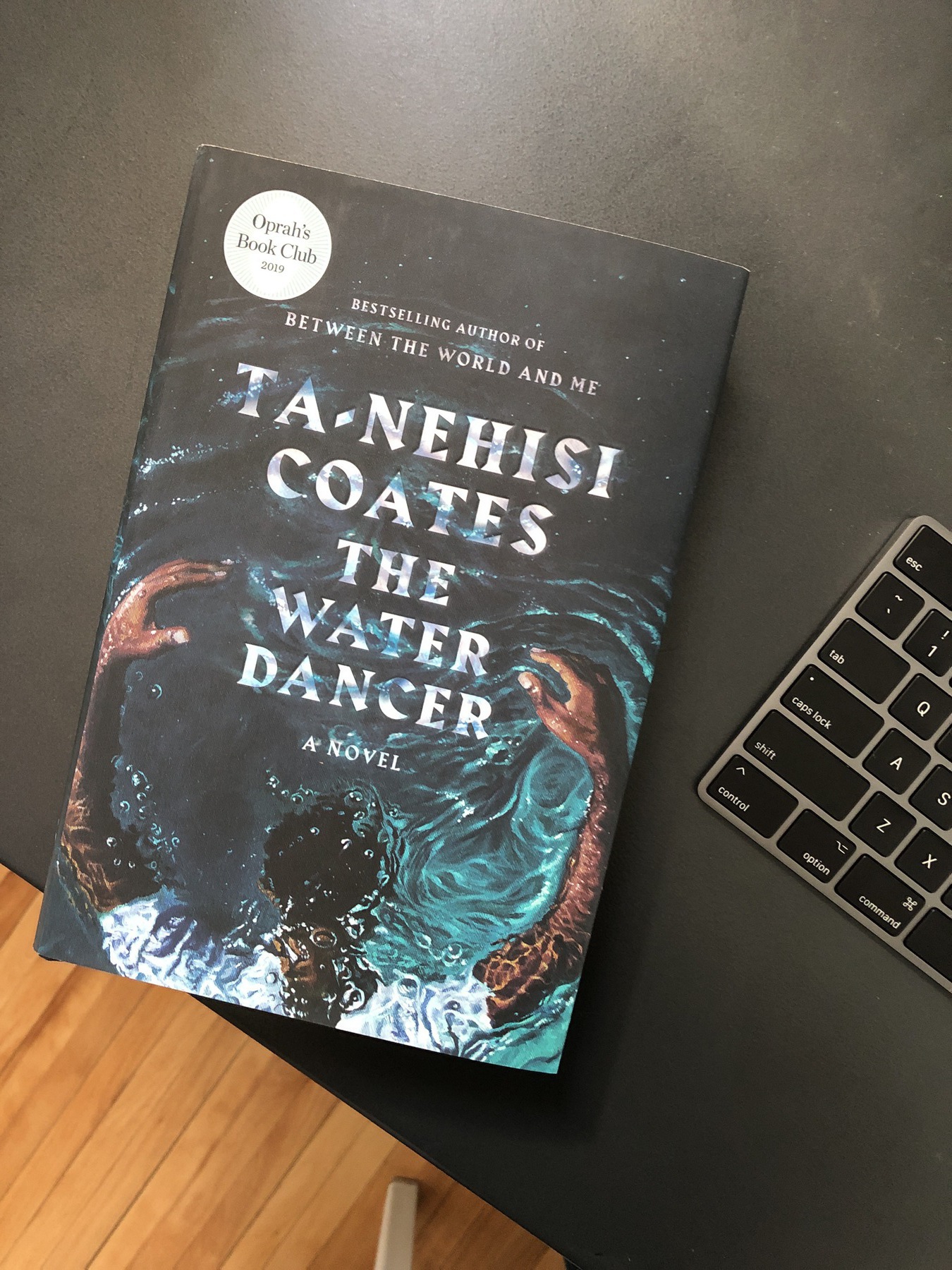
➔ I’m always sleuthing for great advice on meetings, agenda, and whether/why to have one. This is a great tip on seths.blog:
The purpose of a meeting is not to fill the allocated slot on the Google calendar invite. The purpose is to communicate an idea and the emotions that go with it, and to find out what’s missing via engaged conversation.
Just watched Boys State 📺 (Apple + A24 joint). Excellent, superbly cinematic documentary.